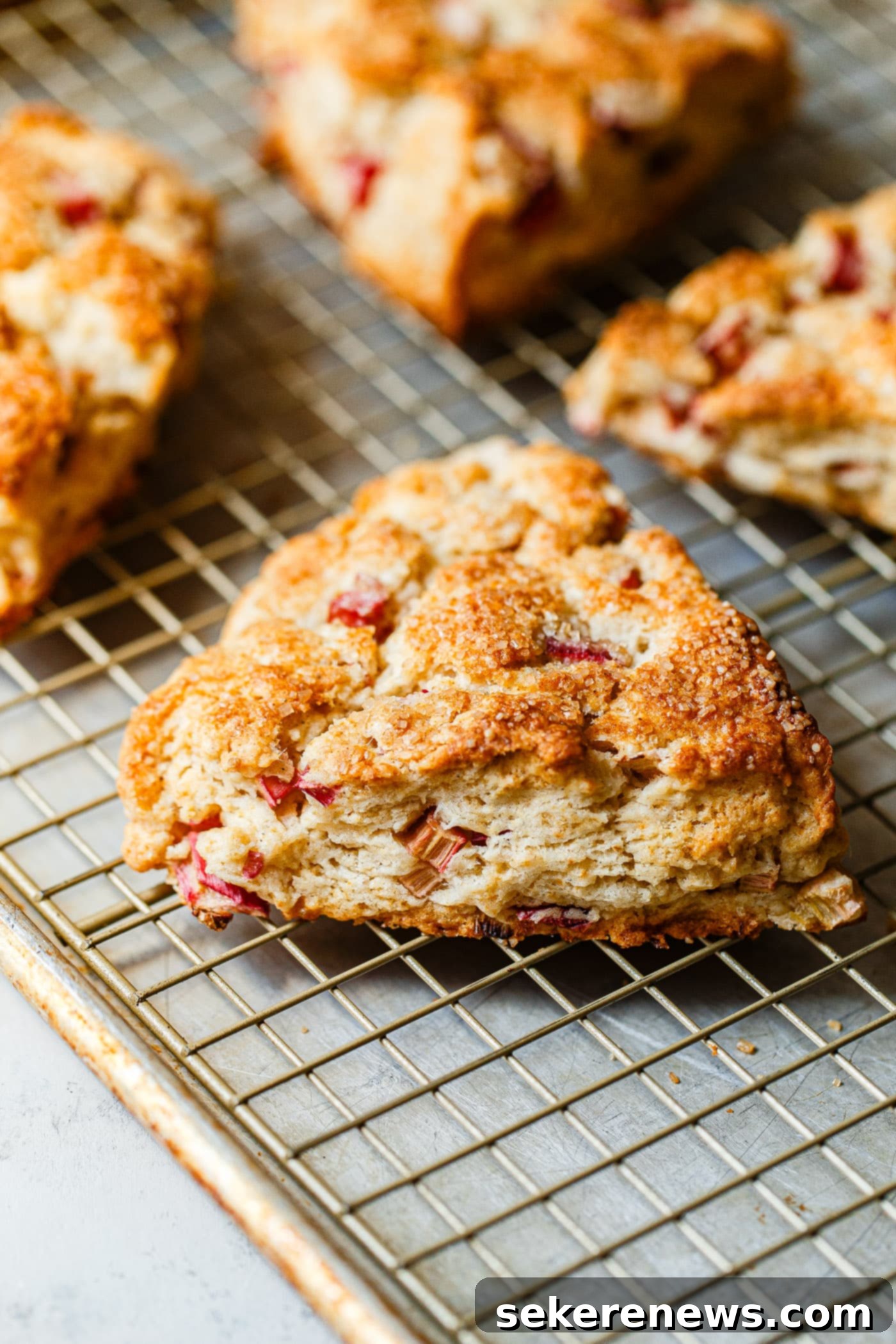The Ultimate Guide to Baking Delicious Rhubarb Scones with Zesty Orange Glaze
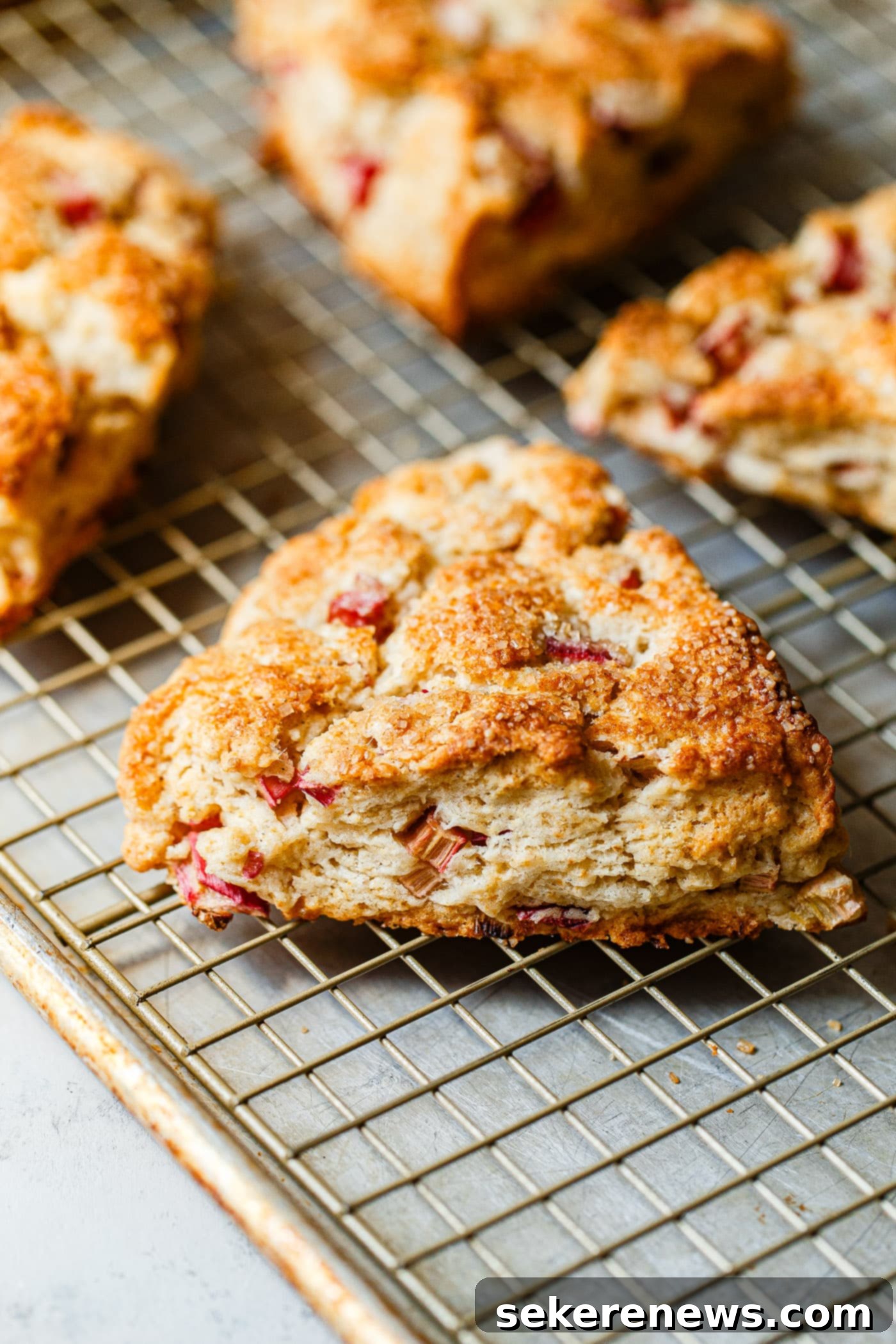
Embrace the vibrant flavors of spring and early summer with these exceptional Rhubarb Scones with Orange Glaze. There’s a special joy in baking with seasonal ingredients, and fresh rhubarb offers a unique tartness that transforms ordinary baked goods into something truly remarkable. For years, I’ve delighted in discovering new ways to showcase the versatility of rhubarb, and this scone recipe has not only met but far exceeded my highest expectations. It has quickly become a beloved staple, celebrating the delicate balance between sweet and tangy in a way that truly shines.
At the heart of this recipe lies a meticulously crafted scone dough, a formula I’ve perfected over countless baking sessions. It relies on the essential combination of *cold unsalted butter* and *chilled heavy cream*. This crucial duo is the secret to achieving scones that are exquisitely tender with a moist, rich crumb, complemented by delightfully crisp, buttery edges. Throughout each scone, you’ll discover pockets of tangy rhubarb, providing a refreshing burst of flavor that cuts through the richness beautifully. The subtle hint of warm spices woven into the dough further enhances the overall profile, creating a truly harmonious taste experience that is both comforting and sophisticated.
But the indulgence doesn’t stop there. To elevate these rhubarb scones to an even higher level of gourmet appeal, each one is generously crowned with a luminous, fragrant, and zesty orange glaze. The bright, citrusy notes of the orange are a perfect partner to the distinctive tang of rhubarb, adding a layer of sweet sophistication that makes every bite an absolute delight. This glaze isn’t just an afterthought; it’s an integral component that brings all the flavors together in a spectacular finish, making these scones irresistible.
Despite their gourmet quality, these scones boast a surprisingly simple preparation process and a wonderfully short bake time, meaning you can whip up a fresh batch almost at a moment’s notice. Whether you’re planning a leisurely weekend brunch, hosting a springtime gathering, or simply craving a comforting treat with your afternoon tea, these scones are designed for convenience without compromising on flavor. To make your baking journey even smoother, I’ve thoughtfully included detailed instructions for reheating and freezing, ensuring that you can enjoy these delectable treats long after they’ve been freshly baked. Get ready to experience scones like never before – flaky, tender, and bursting with the glorious taste of fresh rhubarb and bright orange.
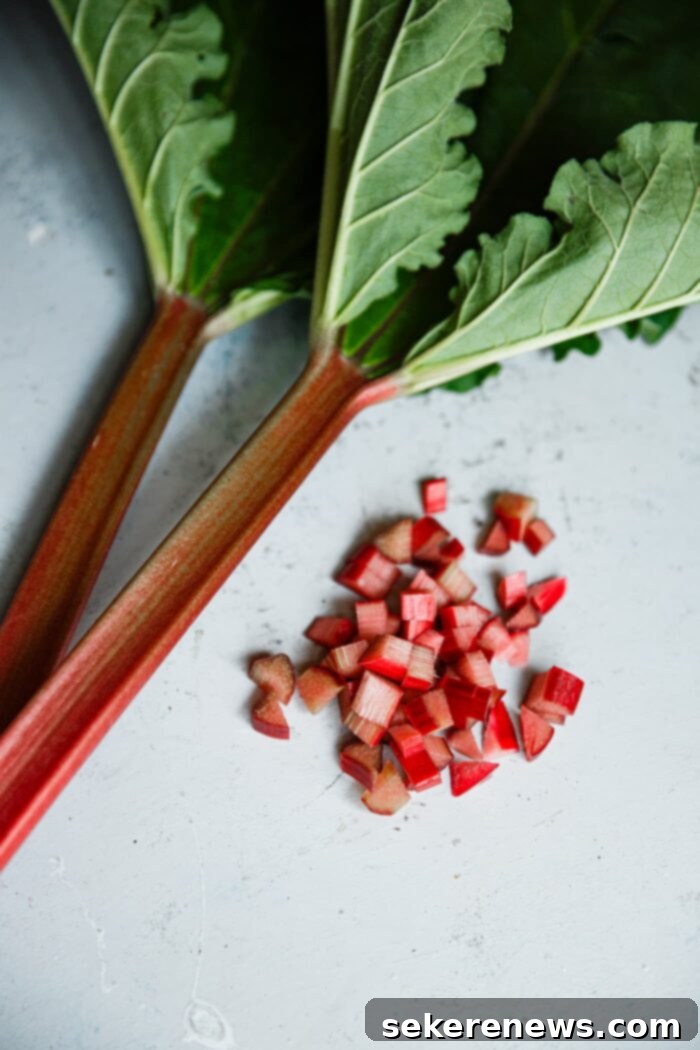
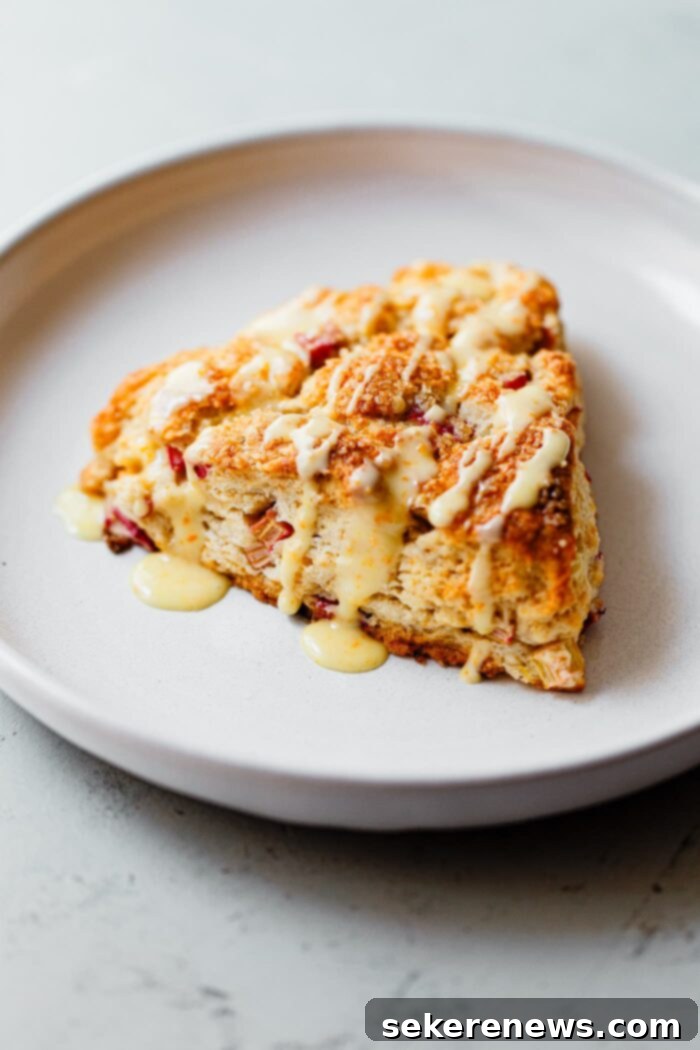
Why You’ll Love These Rhubarb Scones:
- Quick & Easy Preparation – Scones are celebrated for their simplicity, making them one of my favorite breakfast pastries. This recipe epitomizes ease; you can truly whip up a batch with minimal effort and without extensive preparation. Perfect for those busy mornings or when a sudden craving for a freshly baked treat strikes, these scones deliver gourmet results in a fraction of the time typically associated with baking. They’re an excellent choice for beginner bakers or anyone looking for a reliable, no-fuss recipe.
- Unforgettable Texture – Sadly, many scones suffer from a dry, dense, or crumbly texture, giving this classic baked good an undeservedly bad reputation. However, this recipe is meticulously designed to counteract those common pitfalls. By carefully combining cold unsalted butter and chilled heavy cream, we create an ideal scone with a beautifully tender, moist crumb that practically melts in your mouth, perfectly contrasted by crisp, buttery edges. Every bite offers a delightful balance of delicate interior and satisfying crunch.
- Effortless Reheating & Prep Ahead – The convenience of these scones extends beyond their initial bake. They reheat wonderfully, making them perfect for enjoying a warm, fresh-tasting treat days after baking. Just remember to skip the glaze until serving to maintain that perfect texture! Furthermore, similar to cookie dough, you have the flexibility to prepare the scone dough in advance, freeze the cut wedges, and bake them directly from frozen. This makes them incredibly versatile and ideal for smaller households, spontaneous gatherings, or having a delicious homemade breakfast ready to go whenever you desire.
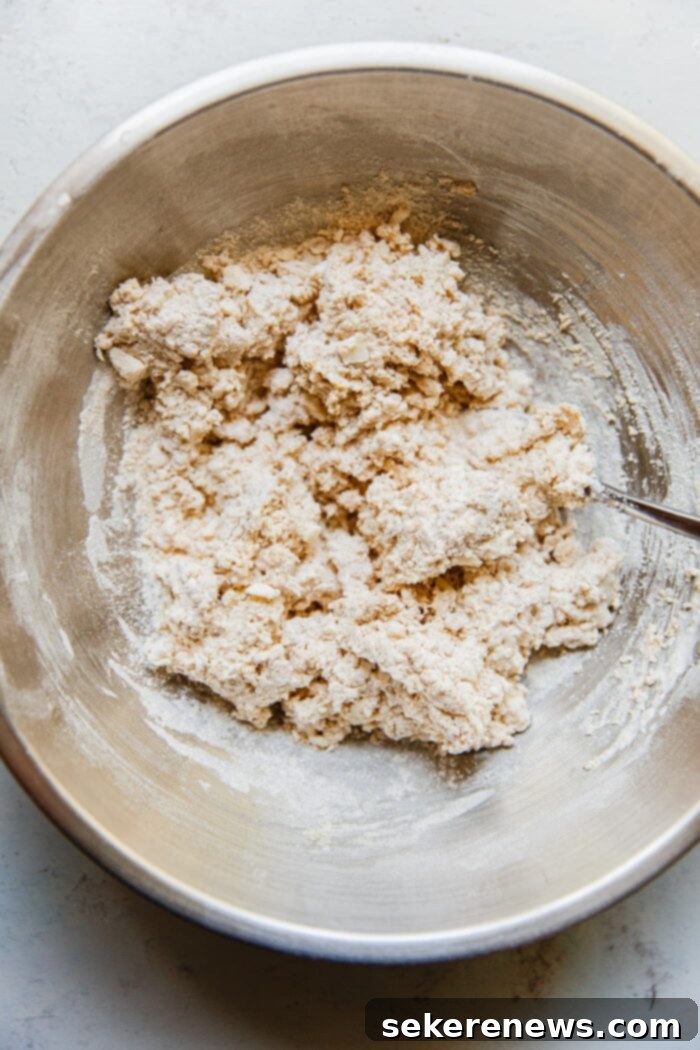
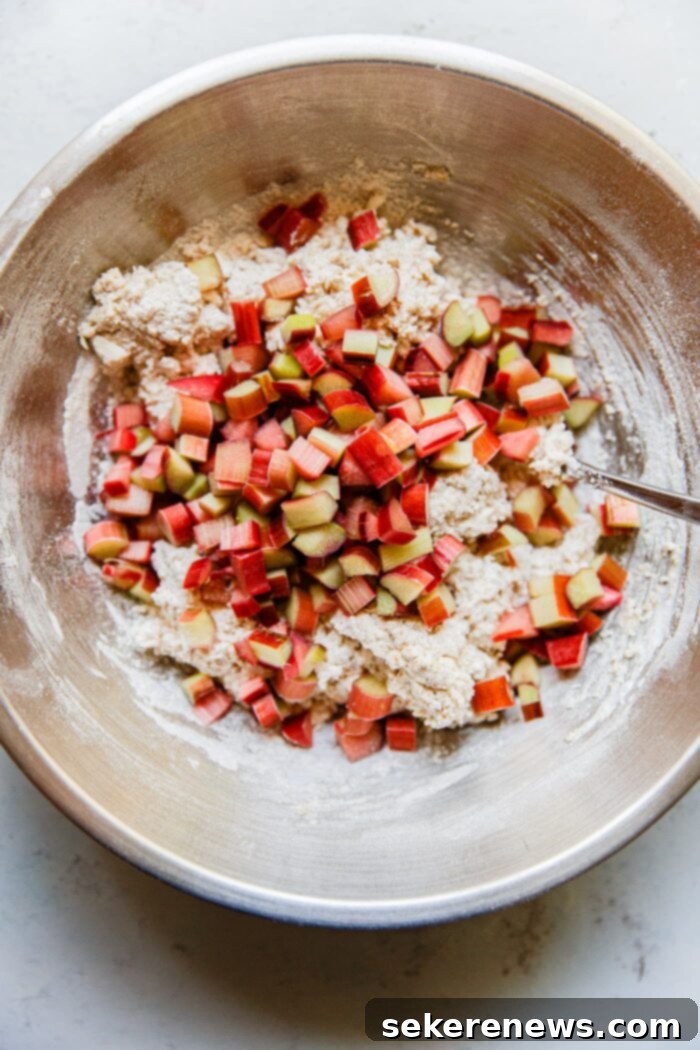
How to Make Rhubarb Scones:
Creating these delightful rhubarb scones is a straightforward process that yields impressive results. The key lies in understanding a few fundamental principles of scone-making, primarily keeping ingredients cold and handling the dough minimally. Below, we’ll walk through the essential steps, providing a narrative overview that complements the detailed instructions in the recipe card.
- Combine Dry Ingredients and Butter: The foundation of perfect scones begins with carefully blending your dry ingredients – flour, sugar, baking powder, salt, and aromatic spices like cardamom and cinnamon – in a food processor. The star of the show here is cold, cubed unsalted butter. Pulsing the butter into the flour mixture creates small, pea-sized pieces. These tiny butter pockets are crucial, as they melt during baking, releasing steam that creates those desirable flaky layers and tender crumb. Transfer this mixture to a large bowl to prepare for the wet ingredients.
- Incorporate Wet Ingredients and Rhubarb: Next, create a well in the center of your flour-butter mixture and pour in the cold heavy cream. Using a large fork, gently mix until the dough just begins to come together in clumps. This is a critical point: avoid overmixing! At this stage, fold in your freshly diced rhubarb. The natural tartness of the rhubarb is a fantastic counterpoint to the sweetness of the scone and glaze. Scrape the dough onto a lightly-floured countertop and gently press it together for just 5 to 10 seconds. Overworking the dough will develop gluten, resulting in tough scones. Pat the dough into an 8-inch disc, about 1-inch thick, and cut into six even wedges before transferring to a lined baking sheet.
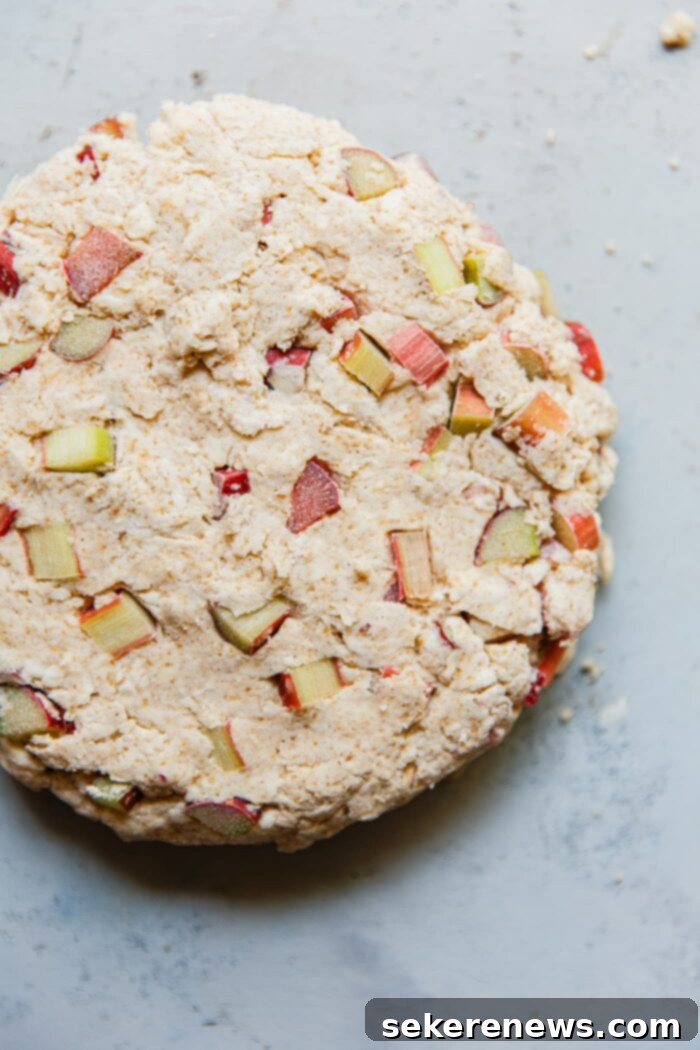
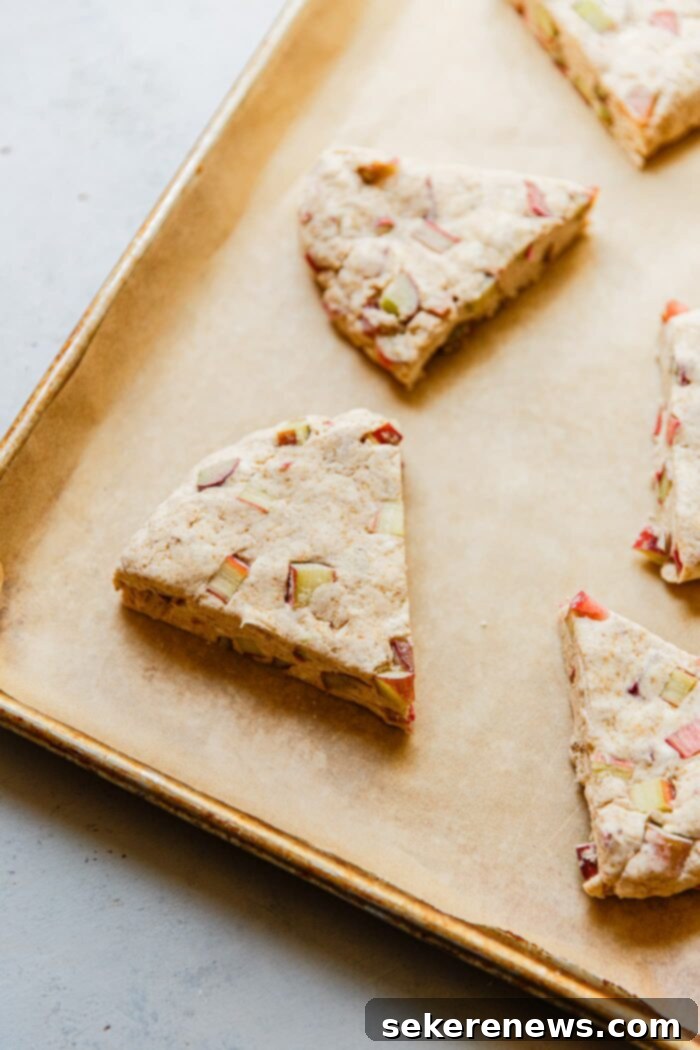
- Bake to Golden Perfection & Glaze: Before baking, brush the tops of the scone wedges with a little extra heavy cream and sprinkle generously with demerara or turbinado sugar. This adds a beautiful golden finish and a delightful crunch to the exterior. Bake until they are wonderfully golden brown, signaling their readiness. Once out of the oven, allow the scones to cool slightly on the baking sheet before transferring them to a wire rack to cool completely. While they cool, prepare the vibrant orange glaze. This zesty topping beautifully complements the tangy rhubarb, providing a burst of citrus sweetness that completes the scone experience. Drizzle the glaze over the cooled scones and let it set before serving.
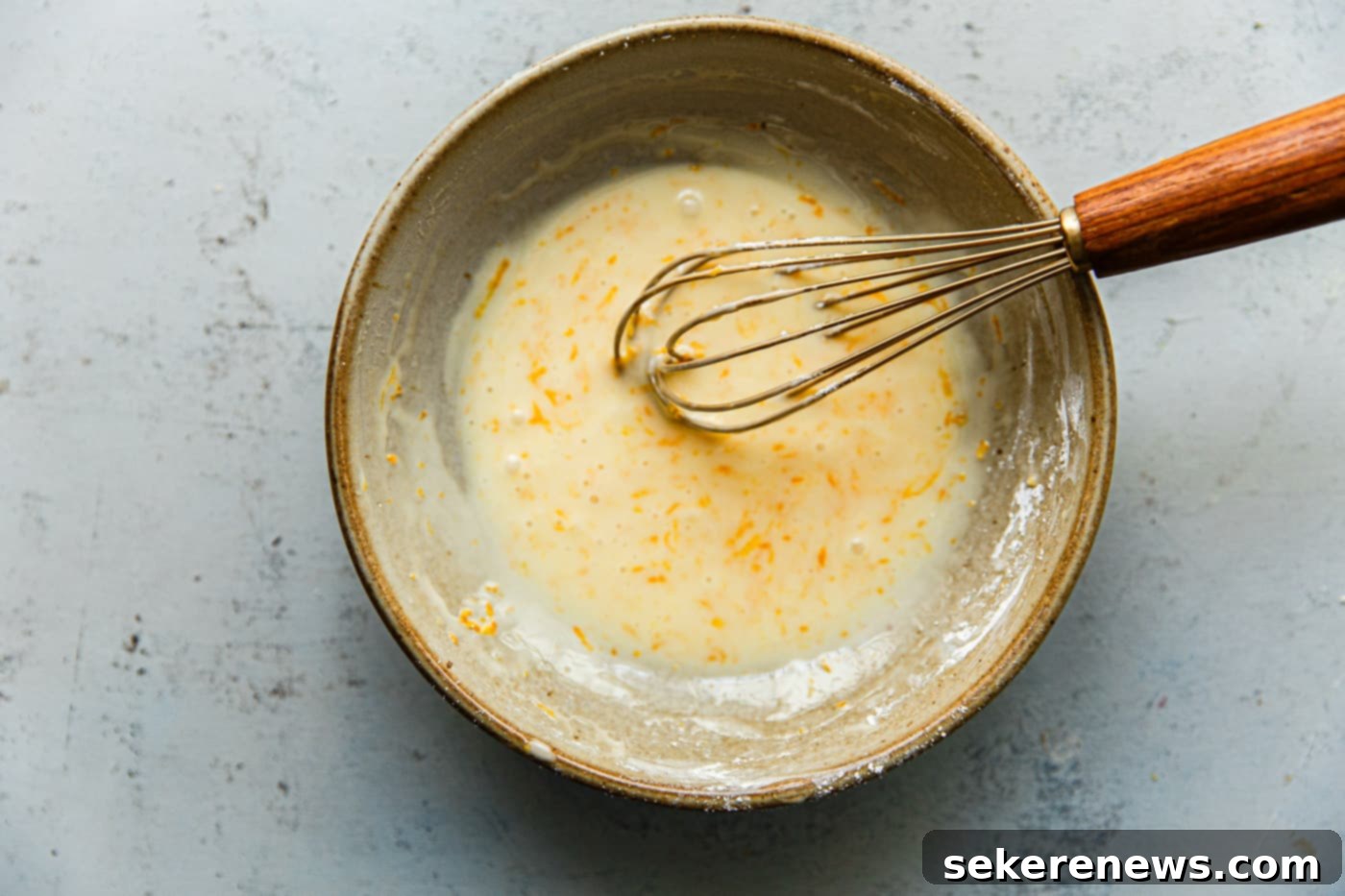
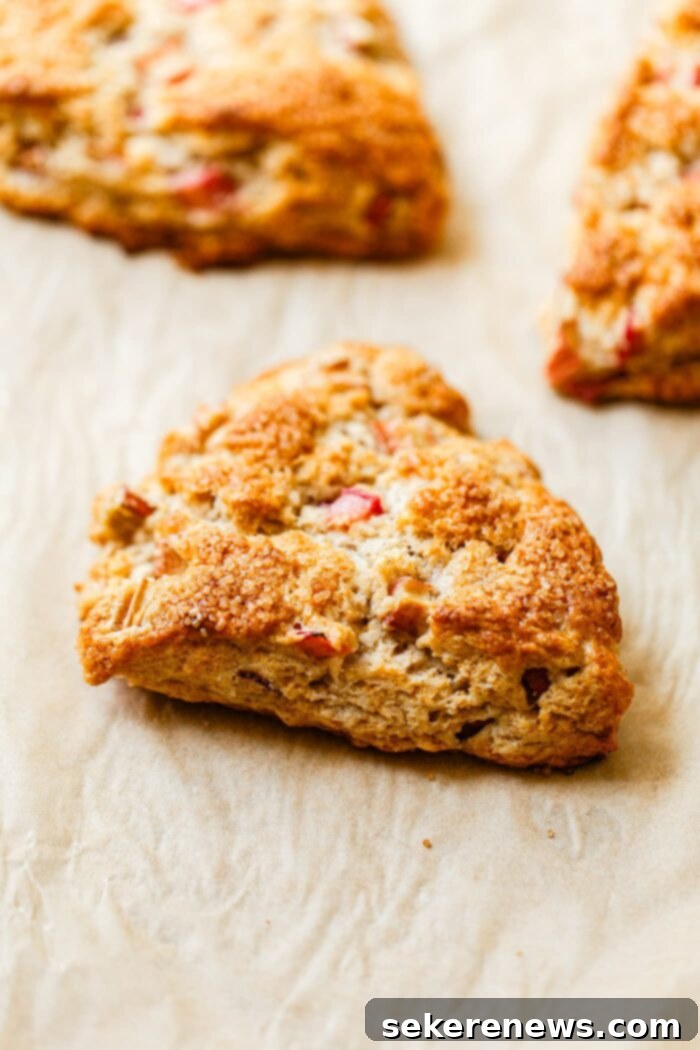
Key Ingredients & Why They Matter:
Understanding the role of each ingredient in this rhubarb scone recipe is crucial for achieving the best results. The right components, handled correctly, ensure that perfect tender crumb and flaky texture.
- Fresh Rhubarb: The star of the show! Rhubarb brings a unique tartness that is beautifully balanced by the scone’s sweetness and the orange glaze. Choose firm, vibrant pink or red stalks for the best flavor and color. Its high water content helps keep the scones moist.
- Cold Unsalted Butter: This is non-negotiable for flaky scones. Cold butter, when cut into small pieces and mixed with flour, creates pockets that release steam during baking. This steam creates layers, resulting in a light and airy texture. Unsalted butter allows you to control the exact amount of salt in the recipe.
- Chilled Heavy Cream: Just like butter, heavy cream should be very cold. The cold fat in the cream contributes to the tender texture and rich flavor of the scones. Using cold liquids helps prevent the butter from melting prematurely, preserving those crucial layers.
- All-Purpose Flour: Provides the structure for the scones. Using unbleached flour can sometimes give a slightly better texture and flavor, but regular all-purpose flour works perfectly well.
- Baking Powder: The primary leavening agent, ensuring your scones rise beautifully and achieve that desired height and lightness. Ensure it’s fresh for optimal lift.
- Cardamom and Cinnamon: These warm spices are the perfect complement to rhubarb. Cardamom adds a unique, slightly floral and citrusy note, while cinnamon provides a classic comforting warmth, enhancing the overall flavor profile without overpowering the delicate rhubarb.
- Orange Zest and Juice: The zest contains fragrant oils that infuse the glaze with bright, aromatic citrus notes, while the juice provides the liquid base and a tangy sweetness that pairs exquisitely with rhubarb, cutting through the richness of the scone.
Tips for Scone Perfection:
Mastering scones is simple with a few expert tips. Follow these guidelines to ensure your rhubarb scones turn out perfectly every time:
- Keep Everything Cold: This is the golden rule for scones. Ensure your butter, heavy cream, and even your rhubarb are well-chilled. Cold ingredients prevent the butter from melting too quickly, which is essential for flaky, tender scones. You can even chill your flour and mixing bowl for 15-20 minutes before starting.
- Don’t Overmix the Dough: Overworking the dough develops gluten, leading to tough, dense scones. Mix just until the ingredients are combined and the dough barely comes together. Lumps are good! A food processor helps achieve this quickly without overhandling.
- Use a Food Processor (or Pastry Blender): While not strictly necessary, a food processor makes cutting in the butter incredibly easy and fast, minimizing the warmth transferred from your hands. If you don’t have one, a pastry blender or two knives work well.
- Gentle Handling: Once the wet ingredients are added, handle the dough as little as possible. Pat it into a disc gently rather than kneading. This preserves the delicate structure and prevents gluten development.
- Sharp Knife for Cutting: A sharp, large knife will cut through the dough cleanly, creating distinct edges that rise better. A dull knife can drag and compress the edges, hindering rise.
- Don’t Skip the Sugar Sprinkle: The demerara or turbinado sugar on top not only adds a lovely sparkle but also provides a caramelized crunch that adds another layer of texture and sweetness to the scone’s crust.
- Bake Immediately: For the best rise, bake the scones as soon as they are shaped. If you must wait, pop them in the freezer for a short period to keep the butter firm.
Serving Suggestions for Your Rhubarb Scones:
These delightful Rhubarb Scones with Orange Glaze are versatile and can be enjoyed in many ways. Here are some suggestions to elevate your scone experience:
- Classic Tea Time Treat: Serve them warm with a pot of your favorite tea, perhaps an Earl Grey or a floral herbal blend, for a sophisticated afternoon snack.
- Brunch Centerpiece: Make them the star of your weekend brunch spread alongside fresh fruit, yogurt, and other pastries. Their vibrant flavor is sure to impress.
- Simple Breakfast: Enjoy a scone with your morning coffee for a quick, yet satisfying start to your day. The citrus glaze offers a refreshing wake-up call.
- Dessert Upgrade: While perfect on their own, for an extra special treat, serve a warm scone with a dollop of vanilla bean ice cream or a spoonful of homemade whipped cream.
- With Extra Spreads: Although the orange glaze is fantastic, a side of homemade rhubarb jam or a classic clotted cream would also complement these scones beautifully.
How to Reheat Baked Scones:
While these scones are undoubtedly best served fresh on the day they are baked, you can absolutely enjoy them later with a little care. The key is to reheat them properly to restore their tender crumb and crisp edges. If you plan on preparing the scones a day or two in advance, it is crucial not to glaze them until serving. This allows for optimal reheating.
- REHEATING SCONES: To bring your baked scones back to life, preheat your oven to 350ºF (176ºC). Place the unglazed, baked scones on a parchment-lined sheet pan. Bake for 10 to 12 minutes, or until warmed through and the edges are crisp again. Transfer to a rack to cool slightly, then prepare and drizzle with the orange glaze as per the recipe instructions before serving.
How to Freeze and Bake from Frozen:
For ultimate convenience, these rhubarb scones are incredibly freezer-friendly. You can prepare the dough in advance and bake them fresh whenever a craving strikes, making them perfect for meal prep or unexpected guests.
- Alternatively, you can prepare the dough, cut them into wedges, freeze, and bake from frozen using these instructions: Prepare the scone dough, cut into wedges, and set them apart on a lined sheet pan. Place the sheet pan in the freezer until the scones are completely solid. Once frozen, transfer the individual scone wedges to a large Ziplock bag, ensuring all excess air is squeezed out and the bag is sealed well. Freeze for up to a month for best quality.
- BAKE FROM FROZEN: When you’re ready to bake, there’s no need to thaw! Preheat your oven to 425ºF (220°C). Place the frozen scones on a parchment-lined sheet pan, spaced several inches apart. Bake for 20 to 22 minutes, or until golden brown and cooked through. The slightly longer baking time at a slightly higher temperature accounts for the frozen state. Transfer to a rack to cool, then prepare and glaze with the orange glaze according to the recipe instructions. This method allows for freshly baked scones with minimal effort, anytime!
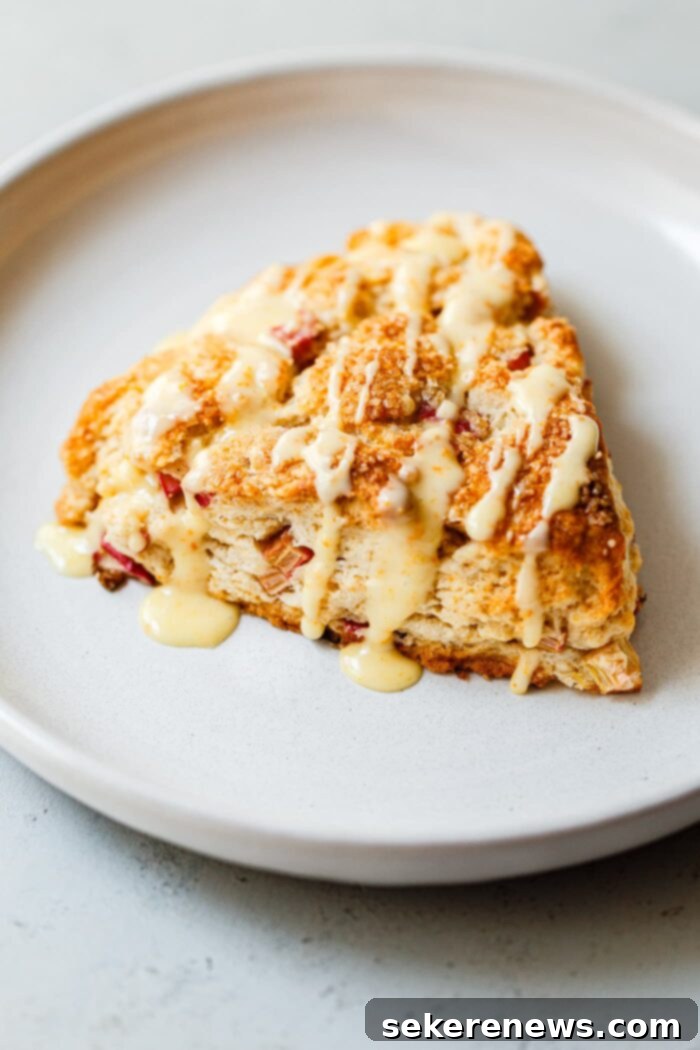
More Scone Recipes to Try:
If you enjoyed these incredible rhubarb scones and are looking to expand your scone repertoire, you’ll love these other delicious variations:
- Raspberry Pistachio Scones
- Orange Chocolate Chunk Scones
- Brown Butter Chocolate Chip Scones

Rhubarb Scones with Orange Glaze
Pin
Review
SaveSaved!
6
Servings
15 minutes
20 minutes
35 minutes
To elevate them further, the scones are topped with a zesty and fragrant orange glaze. The fresh orange complements the rhubarb beautifully and adds a burst of sweetness to each bite. These scones are best served the day they are baked, but they reheat beautifully (just skip the glaze!) and can also be baked from frozen. See the full instructions in the recipe note section.
Equipment
-
Large Food Processor
Ingredients
- 2 cups (240g) unbleached all purpose flour
- 3 tablespoons (36g) granulated sugar
- 1 tablespoon (14g) baking powder aluminum free
- ½ teaspoon kosher salt
- ¾ teaspoon ground cardamom
- ¼ teaspoon ground cinnamon
- 8 tablespoons (4 oz;115g) cold unsalted butter cut into ½-inch cubes
- 1 cup (240g) cold heavy cream plus roughly 2 tablespoons (30g) for brushing
- 7 ounces (200g) fresh rhubarb cut into ½-inch dice (roughly 2 medium stalks)
- 2 tablespoons (14g) demerara or turbinado sugar for sprinkling
Orange Glaze:
- ¾ cup (90g) powdered sugar sifted
- 1 teaspoon fresh orange zest
- 1 tablespoon + 1-2 teaspoons freshly squeezed orange juice
Instructions
-
Preheat the oven to 425°F (220°C) with a rack in the center position. Line a half sheet pan with parchment paper and set aside.
-
Prepare Scones: In a large food processor, fitted with a blade attachment, combine the flour, sugar, baking powder, salt, cardamom, and cinnamon. Pulse several times until all of the ingredients are evenly incorporated. Add cold cubed unsalted butter to the bowl and gently toss in the flour mixture until lightly coated. Pulse 10 to 12 times, or until the butter is no smaller than the size of a pea. Transfer mixture to a large mixing bowl.

-
Create a well in the center of the ingredients, and pour in 1 cup (240g) cold heavy cream. Using a large fork, stir the cream into the dry ingredients. As the dough just starts to clump and come together, stir in the diced rhubarb. Scrape the dough onto a clean, lightly-floured counter-top. Press the dough together gently for 5 to 10 seconds, avoid over-working. Sprinkle with more flour if the dough gets too sticky or difficult to handle. Pat the dough into an 8-inch diameter disc, roughly 1-inch thick.

-
Using a sharp, large knife, cut the dough into six even wedges. Transfer to the lined sheet pan, setting them apart by several inches. Using a pastry brush, brush the tops of the scones with heavy cream, then sprinkle the tops generously with demerara or turbinado sugar. Bake for 18 to 20 minutes or until golden brown. Place on a rack and allow the scones to cool on the sheet pan for 5 minutes, then transfer to a rack to cool completely before glazing.

-
Prepare Orange Glaze: In a small bowl, whisk together the powdered sugar, orange zest, and 1 tablespoon orange juice. It should be thick, but able to be drizzled from the end of a spoon. If the glaze is too thick, add another 1-2 teaspoons of orange juice to thin. If the glaze is too thin, add another tablespoon of powdered sugar (or more, as needed) until it reaches the appropriate consistency.

-
Once the scones have cooled, use a spoon and drizzle the tops of the cooled scones with the glaze. Allow the glaze to set slightly before serving. These scones are best served the day of baking. If you do plan on preparing the scones a day or two in advance, do not glaze the scones and following the reheating instructions in the note section below.

Reheating Instructions:
- These scones are best served the day they are baked. If you do plan on preparing the scones a day or two in advance, do not glaze the scones and follow these reheat instructions: Preheat the oven to 350ºF (176ºC). Place the unglazed, baked scones on a parchment-lined sheet pan and bake for 10 to 12 minutes. Transfer to a rack to cool, then prepare and glaze using the recipe instructions.
Freezing Instructions:
- Alternatively, you can prepare the dough, cut them into wedges, freeze, and bake from frozen using these instructions: Prepare the scone dough, cut into wedges, and set apart on a lined sheet pan. Place in the freezer until solid, then transfer to a large Ziplock bag, excess air squeezed out and sealed well. Freeze for up to a month.
- Bake from Frozen: Preheat the oven to 425ºF (220°C). Place the frozen scones on a parchment-lined sheet pan and bake for 20 to 22 minutes. Transfer to a rack to cool, then prepare and glaze using the recipe instructions.
Serving:
1
Scone
,
Calories:
736
kcal
,
Carbohydrates:
106
g
,
Protein:
10
g
,
Fat:
31
g
,
Saturated Fat:
19
g
,
Polyunsaturated Fat:
2
g
,
Monounsaturated Fat:
8
g
,
Trans Fat:
1
g
,
Cholesterol:
87
mg
,
Sodium:
596
mg
,
Potassium:
233
mg
,
Fiber:
3
g
,
Sugar:
43
g
,
Vitamin A:
1114
IU
,
Vitamin C:
5
mg
,
Calcium:
220
mg
,
Iron:
4
mg
Breakfast, Desserts, Fruit Desserts
American
